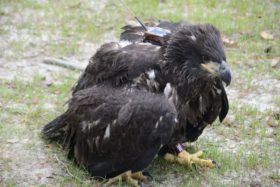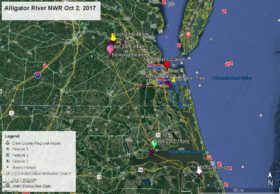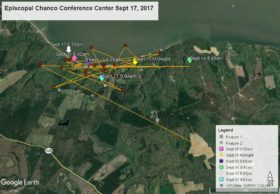Eagle Sunrise Photos Feb 21
Feb 18 Azalea at Mattamuskeet NWR Again
February 20, 2010Azalea Returns to Norfolk Botanical Garden?
February 22, 2010
Categories




Sunrise Feb 21 was just right. No wind, rain or snow. Both the male and female posed for the camera. After spending most if not all the night on nest duty incubating her 3 eggs, it is essential that the female gets some exercise and perhaps breakfast. She, therefore usually leaves the nest before sunrise and the male takes over incubating duties (Photo 1). But, these are “her” eggs and she will not leave them for very long, and thus returns to the nest (Photo 2) and to her caring incubating duty (Photo 3). Although she likely got some good sleep during the night, the warm sun can make an eagle feel the need for a nap (Photo 4).




5 Comments
Thanks, these are great pic of the eagles
I think sunrise on this nest is my favorite time of the day with this eagle pair.
Reese, this is the only way I could figure out how to contact you. I am watching a nest in Shiloh National Military Park in Tennessee. Earlier in the week one of the people in our group of watchers that lives a lot closer than I do got pictures of a juvenile in the nest with the mother while the father sat in a nearby tree. The juvenile late flew with the father to the river and then back to the nest tree. How common is this. My fear is that with so many feet in the nest the eggs will be broken…
I found the following WVEC Eagle Cam blog entry quoting CCB as the source:
“@lapDOGstudio – Source CCB: Not everyone agrees about the night vision of eagles. No question they have outstanding daytime vision. An eagles retina contains more rods than cones, which means it can see in color and has excellent day vision. Birds like owls have more cones and thus have excellent night vision and see in shades of gray. Eagles like some other raptors have two fovea in their retina. One allows them to see at great distance in binocular mode and in color. The other up close in shades of gray and monocular (one eye at a time) mode. While an eagle certainly cannot see as well at night as an owl, I believe that its sharpness of vision does permit it to see better at night than us humans, thus we see them able to fly about at night especially on bright nights.
by Congowings at 9:31 PM.”
I commented back to them that in humans, rods are responsible for night/black/white vision, and cones for red/green/blue=color vision; and asked if she was sure about her comment. The person moderating the blog asked me to ask you the question. Are the functions of rods and cones reversed in Eagles, etc.?
Kent – You are correct. I need to change.